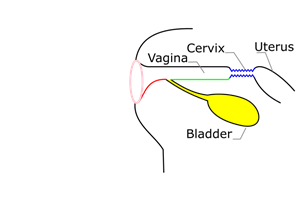There are three structures that can prolapse and be visible under a ewe’s tail: vagina, uterus and rectum. Vaginal and uterine prolapses can affect ewes around lambing and will be discussed here.
Vaginal Prolapse
|
|
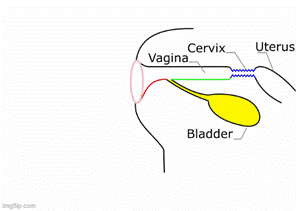 |
A vaginal prolapse occurs when a ewe’s vagina protrudes out of her vulva. Most prolapses occur in the last few days or weeks of pregnancy. It usually starts with the ewe laying down and you just see a small little ball of red tissue protruding from the vulva that retracts when she stands up. This is the ideal time to start treatment and prevent it from progressing to a much more serious situation.
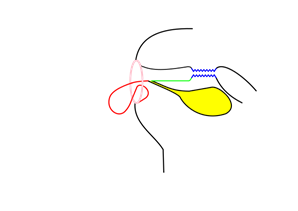 |
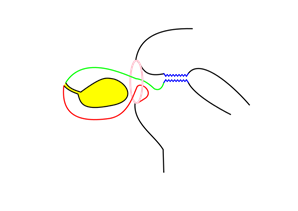 |
 |
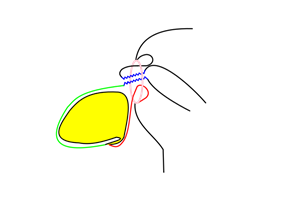 |
If left untreated, more of the vagina will start protruding. This tissue is not supposed to be exposed to the elements and with time it becomes dried out, contaminated with bedding and fecal matter and infection can set in. This is uncomfortable for the ewe and she will start straining, pushing more and more tissue out and making the situation worse. Often the bladder will get caught up in the prolapse and, as it starts filling up, the urethra gets kinked  closed, leading to her not being able to urinate. This leads to even more straining, as she is uncomfortable and trying to urinate without success. With continued straining more tissue is pushed out and the cervix can be seen as part of the prolapse.
closed, leading to her not being able to urinate. This leads to even more straining, as she is uncomfortable and trying to urinate without success. With continued straining more tissue is pushed out and the cervix can be seen as part of the prolapse.
Untreated vaginal prolapse can lead to:
- Abortion or stillborn lambs due to infection entering the normally protected uterus. In the worst case you can lose the ewe too, if the lambs die without her going into labor.
- Ruptured bladder if she is unable to urinate. This will lead to the ewe dying unless it is repaired surgically.
- Damage to the vaginal wall leading to complications during lambing.
- Full tear of the vaginal wall with intestines or uterus being pushed out.
- Improper dilatation of the cervix when she goes into labor, leading to the lambs and ewe dying if you do not intervene.
There are retainers or spoons as well as commercial and homemade versions of harnesses available to keep a prolapse from reoccurring. If you catch it at the stage where the tissue looks normal and the prolapse pulls back in when she stands up, you can just apply a harness and monitor her for recurrence until she lambs. More severe prolapses that do not retract by themselves should be cleaned and lubricated well before gently replacing them and then applying a spoon or harness. If the tissue appears dried out or damaged you should treat her with antibiotics and anti-inflammatories to prevent/treat vaginitis. Otherwise, she will continue straining and make it very hard to get her through to lambing. If the prolapse is very large the bladder is likely caught up in it. Lifting up the whole prolapse towards her tail will often straighten out the kink in her urethra enabling her to urinate and making the prolapse much smaller so you are able to replace it. If you have never experienced a vaginal prolapse in your flock, contact your veterinarian so they can show you the proper way to replace a prolapse and advise you on treatment.
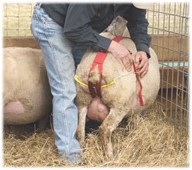 Keep the spoon or harness in place until she lambs. The commercial products claim that ewes can lamb around them but if you see the ewe in full labor, you can remove them to make things easier for her and the lambs. Monitor her after lambing as some ewes will progress to uterine prolapse, especially if there are lambing complications. Other ewes might have a recurrence of their vaginal prolapse after lambing and require a spoon or harness for a few more days.
Keep the spoon or harness in place until she lambs. The commercial products claim that ewes can lamb around them but if you see the ewe in full labor, you can remove them to make things easier for her and the lambs. Monitor her after lambing as some ewes will progress to uterine prolapse, especially if there are lambing complications. Other ewes might have a recurrence of their vaginal prolapse after lambing and require a spoon or harness for a few more days.
Ewes that prolapse vaginally are likely to prolapse again in future pregnancies so culling the ewe after her lambs are weaned is recommended. There might be a genetic component to this so many shepherds will cull her offspring too.
There are a lot of hypotheses about what causes or contributes to vaginal prolapse. Researchers have been studying the causes of vaginal prolapse but have not been able to consistently induce vaginal prolapse in ewes by employing the factors that they identify. The right combination of predisposing factors appears to be necessary to express this condition in ewes, pointing to a complex combination of probable causes. A survey done in Scotland in the 1980’s found that some flocks had no prolapses, some had between 0.1 and 1% of their flock with prolapses and 6% of farms had over 5% incidence of prolapses. If you are seeing a lot of prolapses in your flock you might want to consider some of these possible causes.
Ewes that are too fat – Excess fat in the abdomen decreases the amount of room available for the rumen and pregnant uterus to expand, leading to increased pressure. One study overfed a group of ewes (50% of which had a vaginal prolapse during their last pregnancy) during late pregnancy. 20% of the previous prolapse group re-prolapsed while none of non-prolapse group did. So, being fat by itself does not appear to be enough to cause vaginal prolapse. Another study found that ewes that gained weight between mating and pregnancy scanning did have an increased rate of prolapse but fat ewes that were already fat at mating did not have an increased risk of prolapse.
Ewes carrying multiple lambs – More lambs take up more room in the abdomen. They also need more nutrients so the ewe needs to eat more. Together these factors lead to increased pressure in the abdomen. The risk for prolapse does increase with more lambs, but lots of ewes carry triplets and quads to term without prolapse. Carrying more lambs increases the risk for developing a vaginal prolapse but just by itself does not cause prolapse.
Feeding a bulky diet in late pregnancy – One study found no difference in feeding sheep grain or hay in late pregnancy. Another study also did not find increased risk based on what was fed but did find increased risk if ewes are overfed. Other studies have found increased prolapse risk with low quality feeds. One study did find a protective effect feeding grain divided into two meals rather than one big meal per day. Studies looking at intraabdominal pressure did not find that high fiber diets increase intraabdominal pressure in most animals
Inadequate calcium – smaller studies have found lower calcium levels in ewes that prolapsed vs those who did not. A study comparing flocks with a high incidence of prolapse with those who have low incidence did not find significant differences in calcium between the groups. Another study did find that injecting Vitamin D (which has an effect on calcium metabolism) had a protective effect in adult ewes but did not make a difference in 2-year-old ewes. Another study found that ewes with high phosphate levels were more likely to prolapse.
Genetics – Different breeds of sheep have different rates of prolapse which would suggest a genetic component. It is also seen in certain families within sheep breeds. Studies looking at the overall incidence of prolapse in large studies, however, did not find a reduction in incidence when culling affected ewes and their offspring, which shows that there is an environmental component, too.
Lack of exercise – Grazing animals spend more time walking around vs ewes in a barn that eat at the hay feeder and then lay down, leading to longer times of increased intraabdominal pressure in housed animals. Exercise also helps to increase general muscle tone that can be protective
Feeding high estrogen content diet -Studies have found higher blood estrogen levels in sheep with vaginal prolapse so added phytoestrogens in feed can contribute to prolapse. A lot of sheep are fed alfalfa or clover in late pregnancy with most of them not prolapsing, so this also appears to be a contributing factor but not a cause of prolapse in and of itself. Mycotoxins in feed can also have estrogen-like activity.
Grazing on steep terrain – Studies in New Zealand and Great Britain have found higher incidence of prolapse on farms in hilly areas. When pregnant ewes lay down they prefer laying with their heads up-hill so their full bellies do not put pressure on their lungs, however this puts a lot of pressure on their genital tract and can lead to prolapse. A survey in Scotland in the 1980’s however found a higher incidence in flat land flocks compared to hill flocks.
Age – Some places see more vaginal prolapses in adult ewes, while others see more in ewe lambs and first time lambers.
Uterine Prolapse
A uterine prolapse occurs when a ewe continues pushing after lambing and pushes her uterus out through her vagina. Where a vaginal prolapse is smooth, a uterine prolapse is covered in multiple round, raised caruncles that look like little meatballs. The placenta is sometimes still attached to these structures. A ewe cannot prolapse her uterus and still be pregnant, so there should be a lamb or an aborted fetus somewhere.
Treating a uterine prolapse is an emergency. The uterus will easily get dried out, contaminated by feces and bedding and can easily be torn if it gets caught on something or stepped on by a lamb or another ewe. It is much harder to replace a prolapsed uterus, so ideally you will have your veterinarian do it. While waiting for them, separate the ewe (and her lamb if alive) from the other ewes. Let the lamb suckle if they are able to. Oxytocin is produced when lambs suckle and that will help the uterine muscles contract and shrink down. If the ewe is amenable to it, you can wash the uterus and cover it with a moist towel while you wait. This tissue is very friable so be sure to handle the prolapse gently so you do not damage or tear the uterus. If you are unable to get a veterinarian to replace the uterus for you and are forced to attempt it yourself, you can try the following.
Pour sugar on the tissue and then re-cover it with a towel and let it sit for a few minutes. This will draw some of the fluid out and shrink the tissue some more. Thoroughly wash off the sugar, lubricate the tissue well and gently start pushing the tissue back in. It will take time and she will strain. Stop pushing while she strains and continue when she stops. The uterus is turned inside out like a sock, so you will have to push in at the top, then the sides, then bottom and keep working your way around rather than just trying to push it all in at one spot. Keep working at it and work gently; remember this is friable tissue and a uterine tear can be deadly. When you get to the point where all the tissue is replaced into the vagina, be sure to reach in and make sure that the individual horns are turned back into their normal position, as she will re-prolapse if you do not. Your veterinarian will likely infuse some sterile fluid into the uterus after replacement to make sure that the horns are turned out back into their proper position. A prolapse harness can be applied to prevent recurrence. The ewe should be treated with antibiotics and anti-inflammatories to prevent metritis (uterine infection).
Uterine prolapse is a mechanical problem caused by excess straining after a hard lambing. There does not appear to be a genetic component. Most ewes should breed back and lamb without problems in the future. If there is a lot of damage to the uterus the ewe might not breed back.
By: Isabel Richards, EAPK Communications Committee
Resources/References
Articles on vaginal and uterine prolapse with pictures
https://nadis.org.uk/disease-a-z/sheep/lambing/lambing-part-3-vaginal-and-uterine-prolapse/
https://askavetsheep.wordpress.com/2013/02/02/prolapse/
Prolapse harness and spoons
https://www.premier1supplies.com/p/prolapse-retainer?cat_id=201
https://www.premier1supplies.com/p/prolapse-harness?criteria=Prolapse+Harness
Links to research papers/abstracts on vaginal prolapse
https://cmapspublic3.ihmc.us/rid=1NJFZQSYB-6TCV69-16FX/Prolapses%20in%20Sheep%20and%20Cows.pdf
https://www.tandfonline.com/doi/full/10.1080/00480169.2014.925788?scroll=top&needAccess=true
https://www.tandfonline.com/doi/abs/10.1080/00480169.2019.1696719?journalCode=tnzv20
https://pubmed.ncbi.nlm.nih.gov/3617413/
https://pubmed.ncbi.nlm.nih.gov/12174720/
Information on Rectal Prolapse
https://library.ndsu.edu/ir/bitstream/handle/10365/5339/as1388.pdf?sequence=1
https://u.osu.edu/sheep/2021/05/18/rectal-prolapse-in-small-ruminants/
![]()


